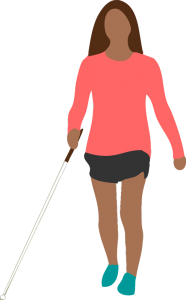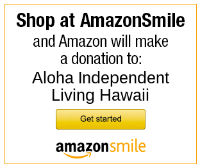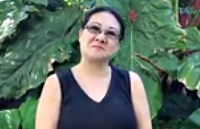It’s been over 4 months since COVID-19 has made its presence in our daily life! The phrases “social distancing” and “physical distancing” are now a part of our vocabulary. We need to take our facemasks wherever we go.
For blind individuals, how do you adjust to this new way of life? A sighted individual can see the 6 foot markers on the ground at stores while standing in line…how would a blind individual know where they need to go? In Pre-COVID times, a blind individual would use their hand to see if someone was sitting in a chair and while doing so touch the back of a person sitting down. That would’ve been no big deal back then, but now, someone might be frightened of catching the virus by someone touching them.
We have some suggestions. When visiting a business or office location such as a grocery store, hotel, government office or any other public place, head for the entrance just as you would do normally. There may or may not be a door monitor. As you approach the door or entrance, you are likely to encounter the public or an official employee. Ask loud enough to be heard, “Is there a line?” or “Which way to the end of the line?” If there is no one present, enter the door wearing a facemask where someone is likely to greet you.
Cane Use
If a person is using a cane and proper technique, he/she should be able to stay five to six feet away pretty easily. If the cane tip hits a shoe, you can stop and even take a step back. The cane does a good job of allowing us to distance just fine in most crowded situations. Although pencil grip is preferred for indoor travel, it would be best to stick that pencil grip out at arm’s length and at a shallow angle to give the maximum distance between yourself and someone in a line. An additional technique is to strike up a conversation with someone in line who you can ask to let you know when the line moves or whose voice you can follow. This technique also works when you follow a restaurant host to your table or a customer service rep at a grocery store as you shop. If you shop with a wagon, follow by holding on to the back of the wagon while the customer service rep guides from the front end.
Finding a Chair
Regarding finding a chair, it is important for people to use their voices and communication skills. While you don’t want someone to be shouting across a room, if you walk up to a table or chair and your cane contacts it, you could ask in a clear voice if there is a vacant chair. “Excuse me, is anyone sitting here? I am looking for an open seat.”
Enclosed Space (e.g. Elevators)
Remember also, that when indoors or in crowded situations we should all be wearing masks and should also have hand sanitizer. In an enclosed area such as an elevator, by using the cane and listening to others, you can step back as needed. If you were to enter an elevator and hear people inside, you could take the opposite corner so each could have their own space as well as allowing others to enter and exit the elevator.
Using Your Hand to Find Something
The use of the back of the hand, forearm, or elbow may work in some situations. When going through a push door, you could use your forearm to push on the handle so your hands are not making contact. When finding a table or chair where it is very loud or you cannot talk for some reason, you might use the back of your hand. Sometimes, by gently pushing on the side of a chair you can determine if someone is sitting in it. If you are in a conference room or around open seating areas such as a couch, then again, the cane tip on the floor can detect a person’s shoes or legs, which is what we teach people to do on buses.
In Conclusion…
Going forward, we will all be a lot more germophobic. When you go to the market, you might utilize customer service much more than you’re used to. They are able to help with picking out produce or meat as you might be reluctant to touch too many things not only for your own safety but because of the way the public will perceive your actions. Remember that even though we provide these tips and other interactions, you should do what’s best for you as well as taking others’ health and well-being into consideration. You might need help, but that doesn’t mean taking away your independence. It is your responsibility to get the correct information before making any decisions or assumptions.
*Mahalo to Dr. Edward Bell and Dr. Frederic Schroeder for their contributions to this guide.




